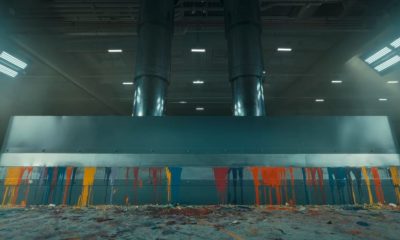Business
How ‘Evil be like’ memes expose our macabre fascinations and fear of death

Twitter is giving some celebrities the evil eye.
You’ve probably seen them on your timeline: photo negatives of celebrities and beloved cartoon characters. It’s called the “evil be like” meme, and it takes your favorite pop culture icon and exposes their dark side — literally.
Just in case you missed it, here are some examples:
What makes this trend unique, however, is that it captures some of our earliest anxieties about film photography and the process of immortalizing ourselves in celluloid, while also shedding light on our collective wariness of celebrity.
Revealing undersides
The nods these memes make to photo negatives and black-and-white photography carries with it the same reservations people have had about the still image for centuries.
We’ve long embraced photography as a way of preserving a moment — or showing us something not visible on the surface. Back in the 1800s, many photographers experimented with double exposure and exploited the practice to show ghostly spirits haunting otherwise ordinary images. Photos like Mrs. Tinkham casted an analogue apparition to convey the belief that a human soul could exist outside its physical body.

Mr. Tinkham and his spirit-wife recognised; William H. Mumler (American, 1832 – 1884); Boston, Massachusetts, United States; 1862 – 1875; Albumen silver print. (Photo by: Sepia Times/Universal Images Group via Getty Images)
Credit: Sepia Times/Universal Images Group via Getty Images
Elsewhere, Abraham Lincoln proved a popular companion for crafty spirit photographers.
While this practice was later debunked, it still signifies our morbid curiosity over death and the afterlife, as well as our collective suspicion of such images. In particular, it demonstrates how the ability to truthfully preserve and capture a moment can be rich with symbolism, impact and resonance.
Some of this tension is at play with these seemingly innocuous celebrity memes. It’s a clever hack at negative exposure in Photoshop, but the effect still connects it to a larger cultural pattern of exposing something not actualized (such as ghosts) or usually visible (evil or criminality). It’s not surprising this trend also takes cues from true crime documentaries and cutaways, which often rely on aggressive negative exposure tactics to suggest culpability.
Look no further than the visual marketing of popular Netflix crime series Evil Genius and Monster Inside for the play with exposure.
Truest versions
At other times in history, photography has been a way of capturing the “other” side of someone — their life and vitality after they’ve died. Humans in the 19th century photographed loved ones and family in post-mortem photography, with an aim to preserve the life of someone otherwise departed.
What’s distinctive about photo negatives is how we assume they’re the truest version of the preserved image — a raw, constructed and untouched version of a photo. Yet, in post-mortem photography of the 1800s, photographers often imbued the deceased with life, manipulating the original negative to give the illusion of rosy cheeks and open eyes.
With “evil be like” memes, there’s a wry pleasure in seeing evil depicted through a photo negative filter. What once symbolized a person’s truest and most unfiltered self now is used to project a much more stylized narrative. Whether it’s the supposed innocence of SpongeBob or the seeming benevolence of Cher, reframing each as harboring a hidden evil taps into a very analogue and dated trust we have with celluloid negatives and “otherness”.
Exposing stardom
Often the primary targets of these memes are figures idolized for their good-natured or celebrated character, highlighting the uneasy duality of celebrity. The trend deconstructs all types of stardom, underscoring how celebrities in particular have visual profiles constructed solely through scripted images and digital fallacies.
Whether Adele and Lorde, or more unsavory characters like Lana Del Rey and James Charles, these inversions are fun because we’re so conscious of how these stars are typically scripted, sanitized and stylized to seemingly always only show us their “goodness” and charisma. And that’s why, when the image cracks, we’re also so very aware.
Seeing a cheeky photo negative of a celeb points to their humanity, showing all stars — even the seemingly good ones — can be tied to traits that we perceive as rotten: narcissism, greed and self-obsession.
The “evil be like” trend utilizes photo negatives because this kind of imagery taps into a rich history of meaning and misgivings. These images seek to show us what’s hidden beneath the surface, whether it’s real or manipulated.
We all have a dark side. Can you see yours?
-

 Business6 days ago
Business6 days agoAI chip startup DEEPX secures $80M Series C at a $529M valuation
-

 Entertainment5 days ago
Entertainment5 days agoJinkx Monsoon promises ‘the queerest season of ‘Doctor Who’ you’ve ever seen!’
-

 Business4 days ago
Business4 days agoStrictlyVC London welcomes Phoenix Court and WEX
-

 Business6 days ago
Business6 days agoRetell AI lets businesses build ‘voice agents’ to answer phone calls
-

 Entertainment4 days ago
Entertainment4 days agoHow to watch every ‘Law and Order’ online in 2024
-

 Entertainment4 days ago
Entertainment4 days agoBookTok and teens: What parents need to know
-

 Business4 days ago
Business4 days agoWhy Apple’s ‘Crush’ ad is so misguided
-

 Entertainment5 days ago
Entertainment5 days ago'House of the Dragon' recap: Every death, ranked by gruesomeness





















